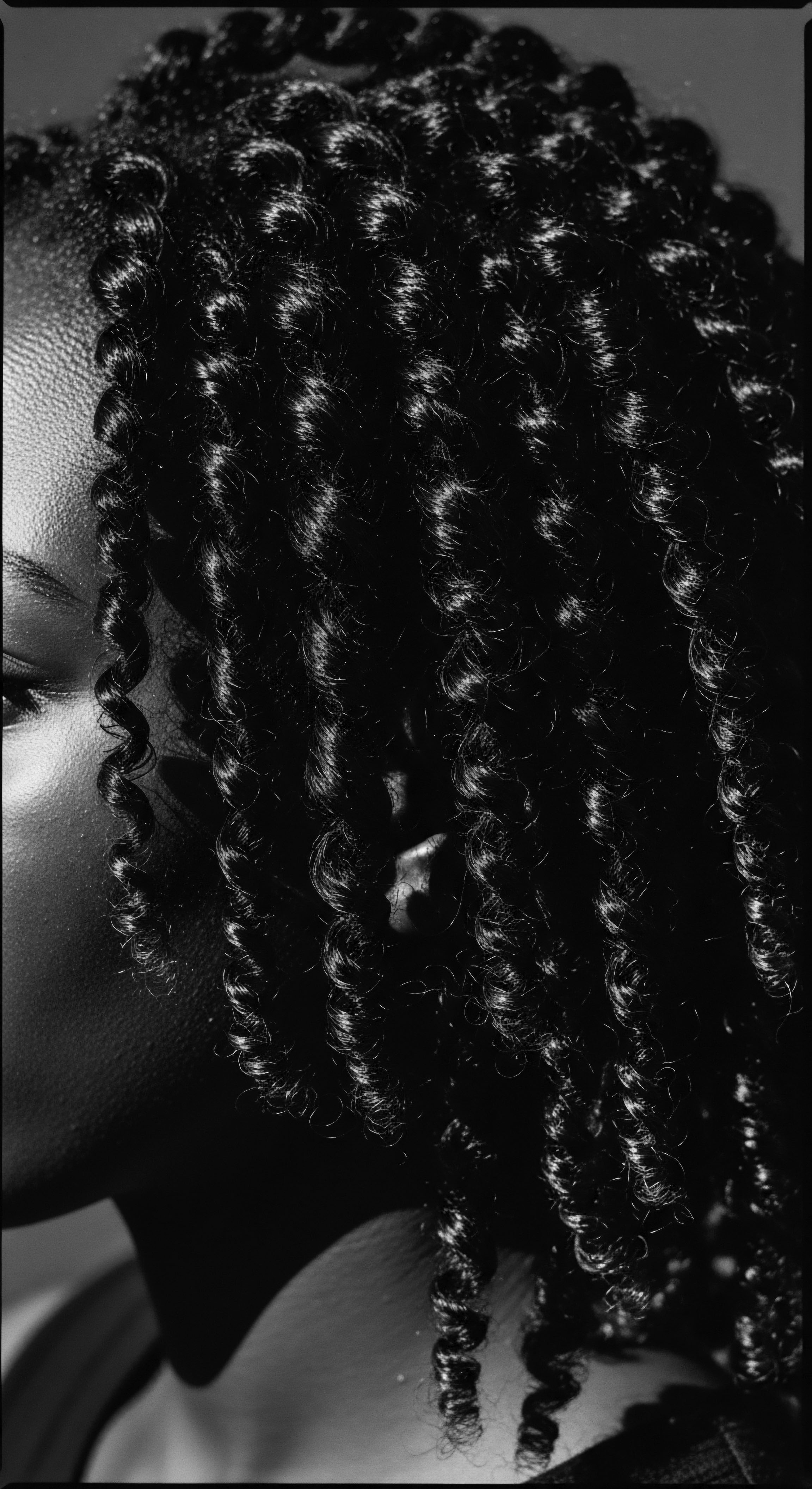
Fundamentals
The Chota Valley Culture, often known as the Valle del Chota, represents a vibrant cultural expression rooted deeply within the northern highlands of Ecuador. This designation points to a distinct Afro-Ecuadorian community, shaped by generations descended from enslaved Africans. Their arrival in the region during Spanish colonial times, primarily compelled to labor on Jesuit-owned sugar cane plantations, set the course for a profound historical trajectory (Handicrafts Wholesale, 2022).
Over centuries, these communities forged a singular identity, blending ancestral African customs with elements from Indigenous and Mestizo traditions present in the Ecuadorian landscape. The Chota Valley stands as a living testament to resilience, a place where the echoes of forced migration transformed into a symphony of unique cultural forms.
A fundamental understanding of the Chota Valley Culture necessarily begins with its geographical placement and historical genesis. Situated between the provinces of Imbabura and Carchi, the valley’s fertile land, irrigated by the Chota River, offered both hardship and a cradle for cultural genesis. The African presence here, originating from diverse West and Central African societies, brought with it an enduring legacy of oral traditions, rhythmic expressions, and communal bonds. This heritage formed the bedrock upon which new cultural practices blossomed in the Andean context.
The Chota Valley Culture represents a powerful synthesis of African heritage and Andean adaptation, forged through centuries of resilience.

Cultural Expressions ❉ A First Glimpse
Musical forms stand as central pillars of the Chota Valley’s cultural statement. The Bomba, a drum with deep African roots, holds prominence in celebrations and rituals (Handicrafts Wholesale, 2022). Its lively rhythms accompany energetic dances, which narrate stories of daily life, historical events, and spiritual beliefs.
Marimba music, another instrument with African origins, also resonates through the valley, serving as a dynamic force in community gatherings (Tourism Ecuador 24, 2025). These soundscapes are not merely entertainment; they are vital conduits for transmitting historical memory and reinforcing shared identity.
The creative spirit of the Chota Valley people finds voice in various artisanal crafts. Hand-woven textiles, often incorporating both traditional and contemporary designs, show the community’s artistic aptitude. Pottery, with patterns mirroring African heritage, exists as another prevalent art form.
Basket weaving, utilizing local materials to fashion functional and decorative items, speaks to a resourceful connection with the land. These crafts, along with culinary traditions that combine African, Indigenous, and Spanish influences, paint a comprehensive picture of a culture that has continuously adapted and preserved its core identity (Handicrafts Wholesale, 2022).
Within this vibrant cultural panorama, hair has always held a special significance. For these communities, hair styling was not simply a matter of personal adornment. It served as a visible register of identity, social standing, and communal affiliation.
The natural textures of Afro-Ecuadorian hair, with their capacity for intricate shaping, lent themselves to a spectrum of traditional expressions that carried profound cultural meaning. The meticulous process of caring for hair, often performed within communal settings, fostered bonds and perpetuated intergenerational knowledge, becoming an essential component of their shared heritage.

Intermediate
Moving beyond a foundational understanding, the Chota Valley Culture can be apprehended as a nuanced study in cultural persistence and reinvention. The core identity of Afro-Ecuadorians in this region developed through a complex process of Syncretism, a dynamic integration of diverse cultural streams. African spiritual practices blended with Catholicism and Indigenous beliefs, resulting in a distinct form of religious expression (Handicrafts Wholesale, 2022). This synthesis extends across all facets of life, from celebrations like San Juan to daily practices and artistic endeavors.
The meaning of the Chota Valley Culture is deeply tied to its historical narrative of displacement and subsequent cultural reclamation. Forced relocation from West and Central Africa brought a vast reservoir of traditional knowledge, spiritual systems, and aesthetic sensibilities to the Andean foothills. Here, in the face of immense adversity, communities actively guarded these ancestral fragments, adapting them to a new environment. This constant negotiation between memory and adaptation shapes their unique cultural landscape, making it a compelling study for anyone seeking to understand the enduring power of heritage.
Cultural practices within the Chota Valley offer powerful insights into human adaptation and the enduring strength of heritage in the face of adversity.

Hair as a Repository of Identity and Connection
The relationship between the Chota Valley community and its hair heritage extends beyond surface aesthetics, becoming a profound aspect of holistic well-being. Hair care practices, often passed down through familial lines, held a deep connection to communal care and traditional wisdom. Textured hair, with its inherent coil and curl patterns, offered a unique canvas for communal artistic expression.
These expressions served as outward affirmations of shared history and collective belonging, creating a visible language that transcended spoken words. The very act of tending to one another’s hair fostered social cohesion, cementing bonds between generations and within neighborhoods.
Consider the ingredients historically used in hair care. Many traditional remedies relied on local botanicals and natural resources, reflecting a deep, inherited knowledge of the land and its offerings. While specific published research detailing Chota Valley hair ingredients is limited, a common thread across Afro-diasporic communities in Latin America involved the use of natural oils, plant-based conditioners, and herbs known for their fortifying properties. This practice underscored a profound understanding of hair as a living extension of the self, deserving of gentle, nourishing care.
| Aspect of Hair Care Cleansing |
| Ancestral Practices in Afro-Diasporic Communities (General) Utilization of natural soaps from local plants, or mild clays and plant ashes for gentle removal of impurities. |
| Contemporary Understanding and Continuation Preference for sulfate-free cleansers that preserve natural moisture; continued use of plant-based washes in some communities. |
| Aspect of Hair Care Conditioning & Nourishment |
| Ancestral Practices in Afro-Diasporic Communities (General) Application of plant oils (e.g. coconut, shea, castor where available), herbal infusions, and natural butters to soften and protect strands. |
| Contemporary Understanding and Continuation Emphasis on deep conditioners, leave-ins, and balms to support moisture retention and fortify hair structure; validation of traditional ingredients by modern science. |
| Aspect of Hair Care Styling & Adornment |
| Ancestral Practices in Afro-Diasporic Communities (General) Intricate braiding patterns, twists, and locs served as social markers, communication tools, and expressions of status. Adornments with beads, shells, or metals. |
| Contemporary Understanding and Continuation Styling practices maintain cultural identity; renewed interest in natural textures, braids, and protective styles. Adornments convey personal style and heritage. |
| Aspect of Hair Care Communal Rituals |
| Ancestral Practices in Afro-Diasporic Communities (General) Hair tending as a shared activity among women and family members, fostering intergenerational learning and social connection. |
| Contemporary Understanding and Continuation Salons and home care spaces retain elements of communal gathering; online communities connect individuals globally in shared care practices. |
| Aspect of Hair Care This table shows how the deep wisdom of ancestral hair care continues to shape contemporary practices, honoring a legacy of intentional care for textured hair. |

Community and Identity
Within the Chota Valley, the shared experience of hair care extended beyond individual beauty. It became a powerful mechanism for reinforcing group identity and collective memory. Children learned the meaning of different styles from elders, receiving both technical skill and cultural narratives alongside each strand.
This intergenerational transmission of knowledge served as a bulwark against the homogenizing pressures of dominant cultures. The very act of styling hair became a quiet, yet potent, act of cultural preservation, a daily affirmation of belonging to a people with an unbroken lineage of ingenuity and grace.
The Cultural Memory held within hair practices provides a window into the broader societal structure of the Chota Valley. Hairstyles could convey marital status, age, or even tribal affiliation, reflecting practices from their African homelands (Afriklens, 2024). This non-verbal communication system allowed for a rich exchange of information within the community, reinforcing social structures and individual roles. Understanding this complex interplay between hair, history, and social fabric allows for a deeper appreciation of the Chota Valley Culture as a whole.

Academic
The academic definition of the Chota Valley Culture requires a precise delineation of its genesis, its socio-historical formation, and its ongoing instantiation as a locus of Afro-Ecuadorian identity. It is a geographically specific yet diasporically connected cultural construct, stemming from the forced trans-Atlantic migration of African peoples and their subsequent establishment within the arid, high-altitude terrain of northern Ecuador (Handicrafts Wholesale, 2022). This community, primarily composed of descendants from enslaved individuals compelled to work on Jesuit plantations, manifests a unique cultural meaning ❉ a dynamic interplay between inherited African epistemologies, practical adaptations to Andean environments, and a persistent assertion of selfhood against historical marginalization (Handicrafts Wholesale, 2022; African American Registry, 2024). The culture represents a profound instance of ethnogenesis under duress, where ancestral memory is not merely preserved, but actively re-created and re-interpreted through lived practices.
From an anthropological perspective, the Chota Valley Culture stands as a significant case study in the resilience of Afro-descendant populations in Latin America. Its cultural meaning is inextricably bound to a history of systemic racial discrimination and economic disparity, yet it continues to demonstrate a remarkable capacity for cultural perpetuation (Handicrafts Wholesale, 2022; Lucas, n.d.). The linguistic patterns, musical traditions, and spiritual syncretisms observable in the valley provide compelling evidence of an enduring connection to West and Central African origins, despite centuries of dispersal and colonial impositions (African American Registry, 2024; Dialnet, n.d.). The very existence of this culture, therefore, offers a powerful counter-narrative to historical attempts at cultural erasure, asserting the indelible mark of African heritage upon the Ecuadorian national fabric.
The Chota Valley Culture symbolizes an enduring legacy of ingenuity, woven into the very fabric of Afro-Ecuadorian identity through cultural expressions like hair traditions.

Hair as a System of Covert Communication and Resistance
A particularly powerful lens through which to comprehend the Chota Valley Culture’s profound connection to textured hair heritage lies in the historical instance of hair as a tool for resistance, a narrative deeply embedded within the broader Afro-diasporic experience in Latin America. During the brutal era of enslavement across the Americas, including regions connected to the ancestral heritage of Afro-Ecuadorians, hair transcended its cosmetic function. It became a clandestine medium for conveying vital information, a silent language spoken through intricate patterns (Fierce, 2024; Lee & Low Books, 2022). This powerful, subtle use of hair offers an extraordinary insight into the ingenuity and resilience of enslaved Africans and their descendants.
Consider the striking example of enslaved African women in Colombia, whose experiences echo through the collective memory of the diaspora. These women ingeniously incorporated detailed cartographic data into their braided hairstyles, creating “maps” that guided escape routes from oppressive plantations (Fierce, 2024). The intricate cornrow patterns, or Canerows, served as visual blueprints, indicating safe passages, locations of water sources, or rendezvous points (How cornrows were used. 2018; YouTube, 2022).
A thick, tight braid tied into a bun, known as “departes,” could signal plans to escape (How cornrows were used. 2018). Curved braids might represent winding roads, while specific knots or deviations could signify landmarks like trees or rivers (Fierce, 2024). This complex system highlights the extraordinary cognitive and communal effort involved in resisting subjugation.
Beyond navigation, these ancestral styles frequently concealed precious resources. Enslaved women would hide tiny gold nuggets, stolen from mines where they were forced to labor, or, even more remarkably, Seeds within their braids (Fierce, 2024). These seeds, carefully secured within the woven hair, represented future sustenance, a promise of planting new life in free settlements, or Palenques. This practice, while not directly documented for the Chota Valley in available historical records, certainly represents a fundamental aspect of the broader Afro-diasporic response to enslavement.
The Afro-Ecuadorian community in the Chota Valley, having themselves faced oppressive conditions and having sought routes to freedom, would have carried forward the spirit and perhaps adaptations of such ancestral knowledge (African American Registry, 2024). The oral histories maintained within Afro-Colombian communities regarding these hair-maps affirm the deep significance of hair as a communication tool (Ancient Origins, 2022). Such historical accounts are vital for understanding the profound cultural meaning attributed to hair in Afro-descendant communities, well beyond mere aesthetics.

Biological and Cultural Intersections of Textured Hair
The unique structural properties of textured hair, often characterized by its elliptical cross-section and high curvature, provide a biological basis for its capacity to be shaped into such resilient and communicative forms (SciELO, n.d.). This inherent quality allowed for the creation of durable, complex styles that could withstand the rigors of daily life and clandestine activities. While often denigrated by Eurocentric beauty standards, the “kinks, curls, or tight coils” of Afro-textured hair possess a singular beauty and versatility, enabling a multitude of styles that are difficult to replicate with other hair types (USC Dornsife, 2016; Safo Hair, 2024).
The sociological significance of hair within African cultures predates the transatlantic slave trade, with hairstyles serving to denote social status, age, tribal affiliation, and even spiritual devotion (Marie Claire Nigeria, 2025; Afriklens, 2024). The act of styling hair was often a communal activity, a social ritual that cemented bonds and transferred cultural understanding from one generation to the next (PsychoHairapy, 2021). The forced shaving of hair during the middle passage was a deliberate act of dehumanization, an attempt to strip enslaved individuals of their identity and connection to their heritage (Library of Congress, n.d.; Nuevo Noir, 2024). The persistence of traditional hairstyles, even in covert forms, became a potent act of resistance, a reclamation of self.
The Chota Valley’s continued practice of certain hair traditions, even those adapted over time, stands as a testament to this deep-seated ancestral value. Hair becomes a “living scripture,” each coil and pattern holding ancestral memory and embodying the resilience passed down through generations (Marie Claire Nigeria, 2025). The meticulous care involved in maintaining textured hair, a practice often dismissed or misunderstood by dominant cultures, speaks to a profound respect for this biological inheritance and its spiritual connotations.

Ancestral Hair Practices and Their Enduring Purpose
The cultural significance of hair within the Chota Valley extends beyond mere aesthetics; it embodies a spiritual connection and historical continuity. Examining the various functions of hair within ancestral and contemporary Afro-Ecuadorian life reveals a deeply layered understanding.
- Identity Affirmation ❉ Hair patterns traditionally signified group membership, marital status, or life stage. These styles served as visible declarations of who one was within the community, providing a sense of belonging amidst a changing world.
- Spiritual Connection ❉ In many African cosmologies, hair is considered the closest part of the body to the divine, acting as a conduit for spiritual interaction (Marie Claire Nigeria, 2025). This belief imbues hair care with sacred meaning, transforming it into a ritual of connection to ancestors and higher powers.
- Communal Bonding ❉ The act of braiding, detangling, and tending to hair often happens in shared spaces, fostering conversations, storytelling, and the transmission of intergenerational knowledge. This communal aspect reinforces social ties and strengthens community solidarity.
- Resistance and Self-Preservation ❉ As previously noted, hair served as a discreet means of communication and concealment during periods of oppression. This historical function highlights hair’s role as a silent form of defiance against attempts at cultural erasure.
- Health and Wellness ❉ Traditional hair care practices, often involving natural ingredients and gentle handling, prioritize scalp health and the inherent vitality of textured hair. This holistic approach connects physical well-being with cultural practices.

Chota Valley’s Role in Afro-Diasporic Cultural Studies
The Chota Valley offers a unique geographical and sociological context for studying the Afro-diaspora. Unlike some larger urban Afro-descendant populations, the Chota Valley community has maintained a strong, localized cultural identity, shaped by both their historical insularity and their continuous efforts to preserve their distinct traditions (Handicrafts Wholesale, 2022). Researchers in anthropology and cultural studies often examine the Chota Valley as a microcosm of broader Afro-Latin American experiences, particularly concerning how remote communities have retained elements of their ancestral heritage.
Academic inquiry into the Chota Valley Culture also grapples with the complexities of Institutional Racism and ongoing marginalization within Ecuadorian society (Lucas, n.d.). Despite significant cultural contributions, Afro-Ecuadorians, including those from the Chota Valley, often face challenges related to poverty, limited access to education, and underrepresentation (Handicrafts Wholesale, 2022). The movement to gain greater recognition and rights for Afro-Ecuadorians is intertwined with the celebration and promotion of their cultural heritage, including the profound meanings embedded in their hair traditions (Handicrafts Wholesale, 2022). Understanding the Chota Valley is therefore an exploration of both historical survival and contemporary cultural assertion.

Reflection on the Heritage of Chota Valley Culture
As we draw close to this exploration of the Chota Valley Culture, a resonant truth settles upon us ❉ its heritage is not a static relic, confined to historical texts or museum exhibits. Instead, it pulses with a living vitality, a continuous narrative spoken through every rhythmic beat of the Bomba, every carefully placed stitch in a textile, and certainly, through each strand of textured hair. The story of the Chota Valley is a testament to the enduring human spirit, a testament to the extraordinary capacity of people to retain, reshape, and rejoice in their ancestral connections even in the wake of profound dislocation.
The textured hair of the Chota Valley’s descendants, with its myriad shapes and spirals, stands as a quiet yet powerful archive. It whispers tales of resilience, of pathways navigated by courageous hands, and of a knowing that runs deeper than any written word. The ancestral wisdom, often conveyed through the communal act of hair tending, forms a gentle, tender thread that binds generations together. This thread reminds us that true care extends beyond surface treatments; it honors the very biology of the hair, seeing in its curl pattern a legacy, and in its health, a reflection of holistic well-being.
The hair of the Chota Valley people holds ancestral wisdom, a living legacy of cultural preservation.
To truly appreciate the Chota Valley Culture means to honor its journey from elemental biology and ancient practices, what one might call “Echoes from the Source,” through the living traditions of care and community, “The Tender Thread.” It compels us to recognize how these foundations culminate in hair’s role in voicing identity and shaping futures, creating “The Unbound Helix.” This journey is one of continuous revelation, showing us that the beauty and strength of textured hair are intertwined with a powerful lineage of ingenuity and defiance. The community’s determination to preserve their unique cultural identity, despite historical challenges, ensures that the spirit of the Chota Valley will continue to shape perceptions and inspire reverence for generations to come. Their hair, truly, is a living, breathing testament to an unconquered heritage.

References
- African American Registry. (2024). The Afro Equadorian Community, a story.
- Afriklens. (2024). African Hairstyles ❉ Cultural Significance and Legacy.
- Ancient Origins. (2022). African Slaves Used Braids to Communicate Escape Routes in Colombia.
- Dialnet. (n.d.). A fresh look at Chota Valley Spanish ❉ An Afro-Hispanic dialect of Northern Ecuador.
- Fierce. (2024). The True Symbolism Mexican Braids in Indigenous Culture.
- Handicrafts Wholesale. (2022). Chota Valley culture, traditions, art and craft.
- How cornrows were used as an escape map from slavery across South America. (2018).
- Lee & Low Books. (2022). The Power of Natural Hair & Magic Like That.
- Library of Congress. (n.d.). Heavy is the Head ❉ Evolution of African Hair in America from the 17th c. to the 20th c.
- Lucas, K. E. (n.d.). Educational Performance in Ecuador’s Chota Valley ❉ The Specter of Institutional Racism. High Plains Society for Applied Anthropology.
- Marie Claire Nigeria. (2025). The Black woman as divine ❉ Sacred femininity in African beauty rituals.
- Nuevo Noir. (2024). The history of Afro hair.
- PsychoHairapy. (2021). Don’t Touch My Hair. But Why?
- SciELO. (n.d.). Hair fiber characteristics and methods to evaluate hair physical and mechanical properties.
- Tourism Ecuador 24. (2025). The Marimba of Chota ❉ Rhythm, Identity, and Afro-Ecuadorian Heritage.
- USC Dornsife. (2016). Kinky, curly hair ❉ a tool of resistance across the African diaspora.
- YouTube. (2022). How Braids Became a Secret Map for Escaping Slavery.
